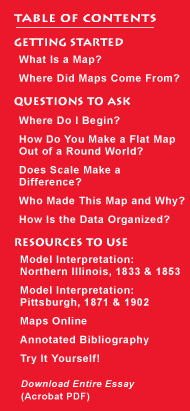talking history | syllabi | students | teachers | puzzle | about us
 |
No one knows for sure when the first map was constructed. A probable scenario suggests that the earliest map was a mental image used by some ancient beings to organize the space in which they lived. Those same beings may have used sounds and gestures to convey spatial information about the local environment to others. Eventually, using a stick to etch a sand canvas that has long since been erased, early humankind may have drawn a likeness of these mental and oral maps. By 2300 BC, Babylonians used clay tablets to record map-like images. Chinese mapmaking traditions date from about the same time. Some early cave and tomb art has map-like characteristics. The Greeks are credited with proving the earth was spherical. Ptolemy, a Greek geographer, created a map of the then known world that marked the culmination of ancient cartography. Following the collapse of the Roman Empire, ecclesiastical influenced "T" and "O" maps dominated cartography for 700 years. These maps with East, the orient, at the top, had water bodies in a T-form separating the continents and an O shaped ocean surrounding them. In 1187, the magnetic compass revolutionized navigation and led to the development of sea charts, or navigational maps. These early charts were drawn by hand on sheepskins. The travels of Marco Polo in the 1270s and 1280s aroused interest in world maps. The rediscovery of Ptolemy's work and its translation to Latin in 1405 coupled with the arrival of the printing press in 1450 further spurred interest in mapping the world. Up until this point in time, maps had to be laboriously copied by hand. Because of their cost and scarcity they were the purview of only the rich and powerful. With the invention of the printing press they could be accurately reproduced on paper and geographic knowledge became more widely disseminated. Improvements in ship design and navigation, along with the rising interest in exploration, led to the development of a clearer picture of the world. As the empty parts of maps were filled in, maps gained wider distribution and use. The rise of nation-states and their military prowess fueled the need for more accurate mapping. World War II was a stimulus for mapping much of the world. In fact, military purposes have been the driving force in the development of modern mapping technology based on satellite imagery. Until the 1970s maps were drafted in pen and ink, a slow and often frustrating process. With the computer, digital maps can be produced very quickly. One downside to the ease of today's mapping is that computers enable unknowing individuals to produce a large number of erroneous maps very quickly. Hence, you need to be a wary map-reader.
|
|||
 |
||||

